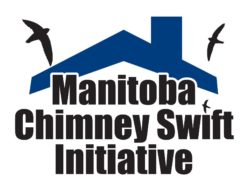
While some swifts have left their summer nesting and roosting sites, we do have some spots where the swifts are still sticking around, or at least were still around as of our last reports! We still have Chimney Swift monitoring reports in Winnipeg, Brandon, Lower Fort Garry, Lockport and Selkirk.
Starting off with Winnipeg! I have a report from Blair Reid from the week before last that didn’t make it into the last blog. On August 18th he watched 690 St Joseph St for the roosting hour and had two entries that went straight down into the chimney. Both Blair and I were curious if there were young in the chimney or recently fledged young, so Blair next monitored the same location on August 24th during the afternoon and then also came back in the evening. During the day he had three swifts down the chimney at once point, with a total of four swifts accounted for in the chimney and in the air. Swifts went down the chimney at 2:17 pm, 2:41 pm and 3:20 pm, with only one exiting at 3:24 pm before he wrapped up the afternoon session at 3:30 pm. When Blair went back for the evening he had an entry, followed by a quick exit (7:51 pm and 7:52 pm) and then two swifts that flew directly into the chimney at 8:17 pm and 8:28 pm. So all in all, still a puzzle! The daytime activity (and extra swift) suggests possible fledged young, but this was not confirmed. We have seen at Lower Fort Garry (where there are confirmed fledglings) that the parents are roosting elsewhere, separate from the young. Perhaps that is the case at this site as well.
Also in Winnipeg, Frank and Jacquie Machovec monitored Transcona Collegiate on August 25th for the roosting hour. They had an interesting evening, different from what they had seen before. They write, “Unlike at other visits, approaches were all very awkward. In the past, entries were straight in from a high level.” MCSI volunteers have not visited Transcona Collegiate often enough to say that these awkward swifts are for sure young from the site. Because of the time of year, they could also be adult swifts who have come from elsewhere that are not quite used to, or practiced in going down a new chimney. Frank and Jacquie saw three entries. The first at 8:08 pm had a missed approach and then it entered successfully, the second entry was at 8:20 pm and had two missed approaches before it entered successfully and the last swift entered at 8:35 pm and had a slow, level approach and entry.
Louanne Reid and Glennis Lewis did their last monitoring session at the two chimneys at the Orange Block building in Brandon on August 25th. They successfully wrapped up the season there with no swifts seen, only a lone goose. A fitting fall migration send-off!
At Lower Fort Garry on August 25th Gerald Machnee still had two swifts using the chimney during the monitoring period. There were four entries and three exits from 8:06 pm until the last entry at 8:36 pm, about 10 minutes after sunset.
On August 25th Bonnie Chartier and Tim Verbiwski were at the St Andrews Lock and Dam Maintenance compound and saw both chimneys were still being used. There was one swift that roosted in the south chimney after having made several passes over the north chimney. There were also two birds that roosted in the north chimney for the night.
In Selkirk Ray Peebles and Sybil Finnson watched the St Merchants Hotel on August 25th but observed no activity this time. It appears the roost of nine birds from August 19th had to vacate their hotel “room” (the chimney)!
Last, but not least, we have our recap from the monitoring at the Selkirk Mental Health Centre. Tim Poole and I joined the folks from Selkirk for their weekly monitoring session on August 23rd for 90 minutes of monitoring starting in the daytime and going into the roost hour. Swift shenanigans were still occurring at one of the towers and the yellow brick chimney, which we were trying to get to the bottom of. Unfortunately, that didn’t happen, and the mystery continues, which you will see in our summary below.
I watched the east tower (2021-T2). It was a very quiet night for me. At 7:46 pm I had one swift flyover, and a flock of 100+ pigeons flew by east of me about half an hour later. Luckily, others had more action.
Tim was watching the large tower (furthest west; 2021-T1). He had no entries into the tower, but saw a lot of action in the air (almost constantly every couple of minutes) by one to two swifts up until 8:38 pm (monitored ended at 9:00 pm).
Robert and Donna Hempler were watching the infirmary building chimney. This site we know had successfully fledged at least one young swift. There was a lot of action with swifts flying overhead, largely going north-south (which fits in the direction of the other active chimney and tower). They did not have any action in their actual chimney until 8:29-8:40 pm when six swifts went down the chimney. Five of the swifts that entered had “fluttered entries”, while one more failed on the first entry attempt but made it into the chimney after flying around the chimney several times.
Nia Massey, Linda Adie and Gerald Machnee watched the yellow brick chimney. They had a total of four birds in the chimney at the end of the night. Leading up to the end of the night there were eight entries and five exits spanning from just after they arrived at 7:20pm with the last entry just after sunset at 8:35 pm.
We continue to see a lot of entries at the stack replacement tower (2021-T4). There was a total of three swifts using the chimney (and staying in the chimney at the end of the monitoring period). The three swifts were very busy going in and out for the entirety of the 100-minute monitoring session. This included 15 entries and 14 exits which works out to visiting the tower 9 times/ hour, a high visitation rate. We are still not sure if this is swifts trying to raise young very late in the season or if young swifts fledged from other nests (infirmary and yellow brick chimneys) and are gathering here. We will have a better idea when the cleanouts of the artificial towers are opened after the swifts leave (mid September) to check for evidence such as fallen nests, eggshells, etc.
That is all for this week. Have a great long weekend and we will be back again next week for another monitoring report summary!
-Amanda
